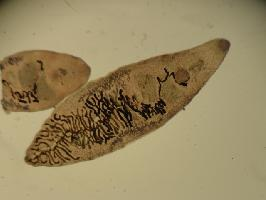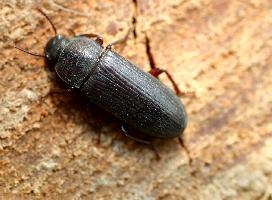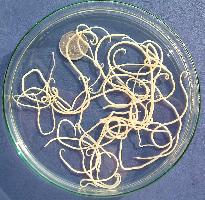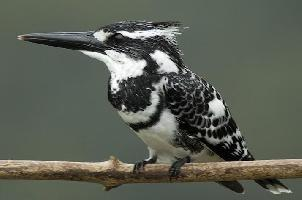
Súlyok és méretek
| Hossz | 6-tól 10-ig mm |
|---|
Veszélyeztetettség
| Rettenthetetlen |
Állatleírás
The Lancet liver fluke, scientifically named Dicrocoelium dendriticum, is a small, leaf-shaped parasitic flatworm belonging to the class Trematoda within the phylum Platyhelminthes. This intriguing parasite has a complex life cycle that involves multiple hosts and precise biological interactions, showcasing the intricate relationships within ecosystems.Adult Lancet liver flukes typically measure between 5 to 10 millimeters in length and 1.5 to 2.5 millimeters in width, with a slender, lancet-like shape that tapers at both ends, giving the parasite its common name. The body of Dicrocoelium dendriticum is covered by a tegument, a specialized type of skin that protects the fluke from the host's digestive enzymes and immune responses. Its color can vary from translucent to a pale yellow or brown, depending on the age and environment of the fluke.
The life cycle of the Lancet liver fluke is fascinating and involves three hosts: terrestrial snails, ants, and finally, grazing mammals such as sheep, cattle, or deer. The cycle begins with the adult flukes residing in the bile ducts of the mammalian host, where they produce eggs that are excreted in the host's feces. When these eggs are ingested by a suitable snail host, they hatch into miracidia, which then develop into sporocysts, and subsequently into cercariae. These cercariae are released from the snail in a slime ball, which is consumed by ants. Within the ant, the cercariae transform into metacercariae, primarily targeting the ant's subesophageal ganglion, which can alter the ant's behavior, making it climb to the top of vegetation during the cooler parts of the day and clamp onto the vegetation, increasing the likelihood of being ingested by a grazing mammal. When the infected ant is eaten by a mammal, the metacercariae develop into adult flukes in the bile ducts, and the cycle begins anew.
The Lancet liver fluke's parasitic lifestyle can have significant impacts on its mammalian hosts, potentially leading to a condition known as dicrocoeliasis. Infections are usually asymptomatic but can lead to liver damage and digestive issues in heavy infestations. Interestingly, the fluke's indirect manipulation of ant behavior, a phenomenon known as "zombie ant behavior," highlights the complex interplay between parasites and hosts, and the sophisticated strategies parasites have evolved to ensure their survival and reproduction.
Despite its small size, the Lancet liver fluke represents a remarkable example of biological complexity and the intricate relationships that define ecosystems. Its life cycle emphasizes the importance of each host species and the delicate balance required for its continuation. As a subject of study, Dicrocoelium dendriticum provides valuable insights into parasitology, ecology, and the evolutionary strategies of parasitic organisms.
Hasonló állatok
Új állatfotók
Top 10 állat
- Dolphin gull (Leucophaeus scoresbii)
- Diana monkey (Cercopithecus diana)
- Moustached guenon (Cercopithecus cephus)
- Galápagos tortoise (Geochelone nigra complex)
- Stone loach (Barbatula barbatula)
- Japanese macaque (Macaca fuscata)
- Greek tortoise (Testudo graeca)
- Russian tortoise (Testudo horsfieldii)
- Common flying dragon (Draco volans)
- Galápagos penguin (Spheniscus mendiculus)


